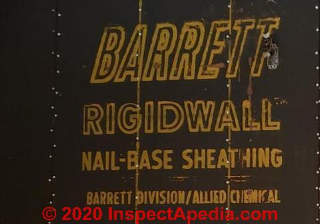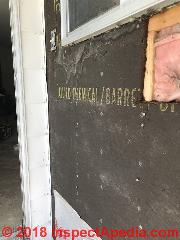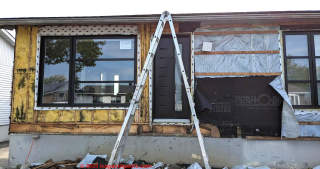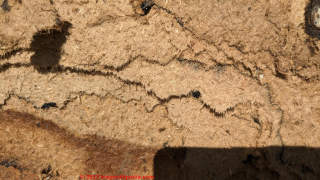 Allied Chemical / Barrett R-Brace Fiberboard Identification
Allied Chemical / Barrett R-Brace Fiberboard Identification
Allied Chemical or Barret Building Wall & Roof Sheathing, Insulating Board Identification Key
- POST a QUESTION or COMMENT about Allied Barrett Rigidwall & similar fiberboard building sheathing: how to identify Allied Barrett fiberboard products, fiberboard uses, and the question: does Allied Barrett fiberboard contain asbestos?
Allied Chemical, Barret R-Brace fiberboard insulating sheathing identification guide.
In this article series we provide fiberboard product names and we describe the components, properties, and applications of various fiberboard, hardboard, and insulating board or sound deadening board products. We also answer questions such as do Celotex or Homasote or other fiberboard and insulating board products contain asbestos? fiberboard water resistance, fiberboard recycling.
InspectAPedia tolerates no conflicts of interest. We have no relationship with advertisers, products, or services discussed at this website.
- Daniel Friedman, Publisher/Editor/Author - See WHO ARE WE?
Guide to Identify Allied Chemical / Barrett R-Brace Fiberboard & Insulating Sheathing Board & Plasterboard Products
 Illustration: Barrett Board "Rigidwall" fiberboard used as an interior OR exterior wall nail base.
Illustration: Barrett Board "Rigidwall" fiberboard used as an interior OR exterior wall nail base.
Fiberboard manufacturers such as those listed in this article series produced cellulose-based fiberboard or "caneboard" from a variety of plant- or wood-fiber sources. These panels were used as an insulating sheathing on building exteriors (mostly walls, rarely roofs).
[Click to enlarge any image]
Barrett Board Asbestos Test Results
I was reading an article a few years ago from inspectapedia. In regards to the fiberboard identification - Allied Chemical / Barret sheathing.
In the article, you stated, "Initial research suggests the answer is no, Barrett R-brace is a cellulose insulating wall sheathing that is not asbestos-based.
But we have not seen asbestos test results from a sample of the material."
After reading this, I decided to have a sample tested from my home that was built in 1964. I have attached the results [PDF just below - Ed.] - Anonymous by private email 2023/01/30
- BARRETT RIGIDWALL BOARD ASBESTOS TEST RESULTS: Negative [PDF] (2021) for Barrett Rigidwall Nail-Base Sheathing, shown in the photo above, in a home built in Lansing Michigan in 1964.
Reader Question: does Allied Chemical/Barrett Division R-brace mediate sheathing contain asbestos?
2018/03/19 Laura said:
Can you please tell me if the Allied Chemical/Barrett Division R-brace mediate sheathing contains any asbestos?
My husband is going to take this sheathing down from a wall in our house and I am concerned about what it’s made with.
Thanks for your help
This question & reply were posted originally
at SHEATHING, FIBERBOARD ASBESTOS CONTENT
Reply: probably not, but we don't yet know for certain
Initial research suggests the answer is no, Barrett R-brace is a cellulose insulating wall sheathing that is not asbestos-based. But we have not seen asbestos test results from a sample of the material.
From the product name and from your photo I infer that this sheathing board was intended to provide some insulation - hence the "R" in its R-brace name - as well as to serve as bracing of a wood-framed wall against lateral movement, hence the "brace" in its name. The photo looks like an asphalt-coated fiberboard product.
Please tell me the country, city, state or province of the building and the year it was constructed as this will help me research your question.
Here is what I have found so far:
Most cellulose or organic fiber building sheathing board is a wood product not an asbestos product, though we've documented some interesting exceptions.
As you've noted, Barrett is and has been (since 1917) a division of Allied Chemical & Dye Co.
A search of the company's current website does not find ANY references to structural sheathing, insulating sheathing, nor R-Brace.
- Okabe, Minoru, J. David Barrett, Hidehiko Fumoto, and Ken McKeen. "Effect of wood density on structural performance of shear walls for post and beam construction." In Proceedings of 8th World Conference on Timber Engineering. 2004.
This article is interesting as it shows a Canadian Barrett still involved in structural sheathing in 2004.
Older U.S. patent disclosures give a view of some of Barrett's products and asbestos use, none of which that I've found so far cite asbestos.
- Holder, John I. "Combined waterproof sheet and flashing receptacle." U.S. Patent 1,377,349, issued May 10, 1921. Original assignee: Barrett Co.
- Eckert, Clarence R. "Siding material." U.S. Patent 2,038,102, issued April 21, 1936. Original Assignee: Barrett Co.
- Swenson, George E. "Lathing for stucco." U.S. Patent 1,731,067, issued October 8, 1929. Original assignee: Barrett Co.
shows us that Barrett was producing panels as a lath substitute in that era. Asbestos is not cited in that patent.
In a 1954 advertisement for sale as an antique document we found confirmation that *some* Barrett products contained asbestos, though this does not tell us about the building sheathing in your photo.
Barrett Asbestos Pipeline Felt "Barrett Asbestos Pipeline Felt is a coal-tar saturated wrapper, shield, and reinforcement. It bonds readily to all coal-tar enamels to provide an inorganic permanent shield.
This felt reinforces the enamel, absorbs impact shocks, and shields coatings against compressive underground forces which tend to disrupt or displace bituminous coatings.
Barrett Industries Contact & History
Barrett Industries, founded by Samuel Barrett descended from Barrett roofing and then Barrett paving materials at the turn of the last century.
The company can be contacted at
- Contact: Barrett Industries (Corporate Office), 3 Becker Farm Road, Suite 307, Roseland, NJ 07068 USA Phone: (973) 533-1001 Email: bpmicorp@barrettpaving.com Website: https://barrettindustries.com/
- HANDBOOK of BARRETT PRODUCTS (2nd Ed.) [PDF] (1927) Barrett Company, Pioneer Building, Ave. C & South 20th St., Birmingham AL USA, retrieved 2020/02/02 original source: https://archive.org/details/HandbookOfBarrettProductsABriefDescriptionOfTheDifferentProducts/mode/2up
Excerpts:
The Barrett Specification Bonded Roof: is the only roof of its kind which receives rigid inspection.
Each layer of felt must be laid exactly right; there can be no buckles or ridges to form water pockets or produce felt breakage. The nails must be well driven and placed in sufficient number to hold the felt in place.
The pitch must be mopped back the full width of the lap so that felt does not touch felt, thus making each course a water- proof blanket in itself. T
he pitch cannot be thinned or diluted by the ad- mixture of tar or oil. Overheating pitch is prevented by our inspectors, each of whom is equipped with a thermometer.
The poured top coat, applied under Barrett inspection, means that the roof gets just twice as much pitch on the surface as on an ordinary built-up roof. T
he gravel or slag must be from y$ to &i inch in size and free from dust or dirt. It must be em- bedded in the pitch while hot.
Barrett Specification Felt: The finest grade of coal tar saturant produced is used to saturate Specification Felt. It is always thoroughly saturated and thoroughly seasoned. - Barrett, William H., and John C. Hart. METHOD of TREATING COATED FIBERBOARD [PDF] U.S. Patent 3,092,508, issued June 4, 1963. Filed Sept 20 1960.
Excerpt:
The present invention relates to production of coated fiberboard panels of cellulosic fibers, and more particu larly to preventing cupping of such coated panels.
Rigid insulation board of cellulosic fibers is well known, varying in density within the range of about 12 pounds to about 24 pounds per cubic foot, and being commonly of a density of approximately 18 pounds per cubic foot.
So constituted, such board has porosity and it is com pressible. It has long been the practice to merchandise such panels with decorative coatings thereon. Because cellulosic fibers tend to discolor on exposure to light and air, the fibers are hidden by pigment in applied coating composition.
Fiberboard panels are often sold as tileboard which are marketed in sizes varying from 12' x 12' to very large sizes, and a thickness of about A6' to about 1'.
The coated fiberboard panels, such as tile, have a tendency to cup toward the coated surface. This cupping may occur before the tiles are applied and in some instances after application.
It is the general object of the present invention to elim inate or substantially eliminate cupping of coated cellu losic fiberboard panels. - Barrett Jr, Arthur M. "Ring binder." U.S. Patent 4,566,817, issued January 28, 1986.
- Hart, John C., and Edgar A. Lauring. Fissured coated fiberboard and method of manufacture [PDF] U.S. Patent 2,947,647, issued August 2, 1960.
Excerpt:
This invention relates to acoustical tiles and to meth ods of manufacturing them. One of the objects of this invention is the provision of an acoustical tile that is provided with a fissured sur face which results in high sound absorbing efficiency.
Another object of the invention is to provide an im proved method of treating the surface of a fibrous build ing unit in order to improve the appearance of the prod uct and enhance its sound-absorbing properties. The method of treating provides an open surface resembling travertine marble. - Lauring, Edgar A. FLAME RESISTANT FIBERBOARD [PDF] U.S. Patent 2,813,046, issued November 12, 1957. [Cited by Barrett in 1963 in discussing fiberboard coatings - Ed.]
Excerpt:
This invention relates in general to fire retarding coat ings for fibrous materials including particularly composi tion wall board such as fiber insulation board and the like or other surfacing materials. More specifically, the invention relates to fire retarding coatings which are intumescent and which thus have ad ditional fire retarding properties resulting from such in tumescence.
The use of fire retarding coatings which are intumescent to some extent is not entirely new. The principal de fects heretofore in such coatings have been that the re sulting coatings are not washable and are easily marred.
The usual formulation of such fire retarding coatings in cludes a carbohydrate in combination with a soluble salt of some known fire retarding property. The carbohydrate acts as an inhibitor for the crystallization of the salts and holds it firmly in the treating material.
The fire retardant of this type is not washable and is easily marred and, therefore, cannot be cleaned in the normal manner.
...
An object of the present invention is to provide an improved fire retarding coating which will be washable. A related object is to produce an intumescent coating which will be relatively scuff resistant.
Other Barrett Patents to exclude
- Barrett, Arthur M. "Platform." U.S. Patent 1,993,237, issued March 5, 1935.
Excerpt:
This invention relates to platforms and more particularly to portable industrial platforms, commonly known as skids, or portable loading and transporting platforms, for use with lifting or elevating and transporting trucks, as well understood in the art. - Barrett, Paul K. "Crack filling tool." U.S. Patent 2,214,219, issued September 10, 1940.
Excerpt:
My invention relates to a tool for filling cracks in plastered walls or the like ...
...
Reader Comments, Questions & Answers About The Article Above
Below you will find questions and answers previously posted on this page at its page bottom reader comment box.
Reader Q&A - also see RECOMMENDED ARTICLES & FAQs
On 2023-05-12 by InspectApedia Editor - Barrett Board composition and asbestos question
@Simon Blain,
Thank you for the Barrett Board composition and asbestos question.
Indeed there is a lot of discussion of Barrett board above on this page - 48 mentions in fact, including one reader asbestos test report.
It's a wood or plant fiber product. Exactly what plant or wood waste species was used varies across the product history.
On 2023-05-12 by Simon Blain
Hi, really glad to have found this page, lots and lots of information! However, I cannot find the specific products that is installed on my house, that is "Therm-o-bar". House was built in 1970 and is in Laval (suburb of Montreal).
From what little I have been able to find on Google, it was manufactured by The Barrett Company division of Allied Chemical. I have looked at every page on Google I could find to see if this would contain Asbestos or not. I found many old adverts for the product, none of them specify Asbestos...but then again, none of them mention what they're made of!
Curious if anyone has any info on this material. Thanks!
Question: Can I mud and tape over this Barret-Board Nail Base?
Hi ,can you tell me if you can mud , tape and paint barrett rigid wall sheathing ? Can you mud and tape Barrett rigid wall board ? and ofcourse paint. - Jim 2020-01-31
Reply: Don't mud directly over Barrett Board Rigidwall sheathing without checking its coating
Jim
Fiberboard sheathing had a long history of successful use as a plaster base as a substitute for wood-lath or metal lath systems.
However depending on the particular fiberboard composition and coatings, it may either not bond well with joint compound or might suffer bleed-through staining.
I wouldn't mud over Barrett nailbase without checking with the manufacturer about the the specific Barrett Rigid-Wall Board product you have.
For example, at least some early Barrett sheathing products are described in the company's product handbook as making use of coal tar pitch.
Excerpt: Today the unvarying excellence of Barrett Pitch and Felt is absolutely assured by the most rigid and scientific laboratory control throughout the manufacture. - product handbook cited below.
If you encounter a polyethylene, polyisocyanurate or other plastic skinned nailbase (An Allied Chemical product) typically used as exterior sheathing then that is not a surface that would bond well with joint compound, mud, tape, or even most paints.
Can you give me the country and city of the building and the building age?
...
Continue reading at Xspan class="LI_Spaced"> UNIDENTIFIED FIBERBOARD PRODUCTS or select a topic from the closely-related articles below, or see the complete ARTICLE INDEX.
Or see these
Recommended Articles
- INSULATION IDENTIFICATION GUIDE - home - identify various insulating board products
- MDF Medium-Density Fiberboard DEFINITION & CHARACTERISTICS
- SHEATHING, FIBERBOARD - home
- CANEBOARD PANELS
- CARDBOARD CORRUGATED FIBERBOARD
- CELOTEX HISTORY & PRODUCTS
- DEFINITION of FIBERBOARD SHEATHING
- FIBERBOARD CEILING & WALL COVERINGS
- FIBERBOARD MANUFACTURERS & BRAND NAMES
- FIBERBOARD PANEL REPAIR
- FIBERBOARD PLASTER BASE SYSTEMS
- FIBERBOARD PROTECT from WATER
- FIBERBOARD ROOF SHEATHING
- FIBERBOARD ROOFING & FIBER-WOOD ROOFING
- FIBERBOARD SHEATHED WALL BRACING
- FIBERBOARD SHEATHING ASBESTOS CONTENT
- FIBERBOARD SHEATHING FIRE RATINGS
- FIBERBOARD SHEATHING IDENTIFICATION - home
- FIBERBOARD SHEATHING INGREDIENTS
- FIBERBOARD SHEATHING INSECT DAMAGE
- FIBERBOARD SHEATHING MOLD CONTAMINATION
- FIBERBOARD SHEATHING MSDS
- FIBERBOARD SOUND INSULATION
- HARDBOARD MASONITE™ & OTHER BRANDS
- HARDBOARD Masonite™-like INGREDIENTS
- HARDBOARD & MASONITE USED in WORKS OF ART
- HISTORY of FIBERBOARD INSULATING SHEATHING
- HOMASOTE HISTORY & PRODUCTS
- SHEATHING, FIBERBOARD ASBESTOS CONTENT
- SHEATHING FIBERBOARD CONSTRUCTION
- SIDING HARDBOARD IDENTIFICATION & CLAIMS
- SUNDEALA BOARD COMPOSITION & HISTORY
- SYNONYMS for FIBERBOARD SHEATHING
- UNIDENTIFIED FIBERBOARD PRODUCTS
- WOOD FIBRE INSULATING PANELS
Suggested citation for this web page
IDENTIFY ALLIED CHEMICAL / BARRETT R-Brace Insulating Board & Fiberboard at InspectApedia.com - online encyclopedia of building & environmental inspection, testing, diagnosis, repair, & problem prevention advice.
Or see this
INDEX to RELATED ARTICLES: ARTICLE INDEX to BUILDING STRUCTURES
Or use the SEARCH BOX found below to Ask a Question or Search InspectApedia
Or see
INDEX to RELATED ARTICLES: ARTICLE INDEX to BUILDING INTERIORS
Or use the SEARCH BOX found below to Ask a Question or Search InspectApedia
Ask a Question or Search InspectApedia
Try the search box just below, or if you prefer, post a question or comment in the Comments box below and we will respond promptly.
Search the InspectApedia website
Note: appearance of your Comment below may be delayed: if your comment contains an image, photograph, web link, or text that looks to the software as if it might be a web link, your posting will appear after it has been approved by a moderator. Apologies for the delay.
Only one image can be added per comment but you can post as many comments, and therefore images, as you like.
You will not receive a notification when a response to your question has been posted.
Please bookmark this page to make it easy for you to check back for our response.
IF above you see "Comment Form is loading comments..." then COMMENT BOX - countable.ca / bawkbox.com IS NOT WORKING.
In any case you are welcome to send an email directly to us at InspectApedia.com at editor@inspectApedia.com
We'll reply to you directly. Please help us help you by noting, in your email, the URL of the InspectApedia page where you wanted to comment.
Citations & References
In addition to any citations in the article above, a full list is available on request.
- Jester, Thomas C., ed. Twentieth-century building materials: History and conservation. Getty Publications, 2014.
- ANSI /AHA - A194.1, Cellulosic Fiberboard.
- U.S. Department of Commerce: PS57-73, Cellulosic Fiber Insulating Board
- A.F.A. (2003): Fiberboard Sheathing test results
CONTINUE READING or RECOMMENDED ARTICLES.
- Carson, Dunlop & Associates Ltd., 120 Carlton Street Suite 407, Toronto ON M5A 4K2. Tel: (416) 964-9415 1-800-268-7070 Email: info@carsondunlop.com. Alan Carson is a past president of ASHI, the American Society of Home Inspectors.
Thanks to Alan Carson and Bob Dunlop, for permission for InspectAPedia to use text excerpts from The HOME REFERENCE BOOK - the Encyclopedia of Homes and to use illustrations from The ILLUSTRATED HOME .
Carson Dunlop Associates provides extensive home inspection education and report writing material. In gratitude we provide links to tsome Carson Dunlop Associates products and services.




